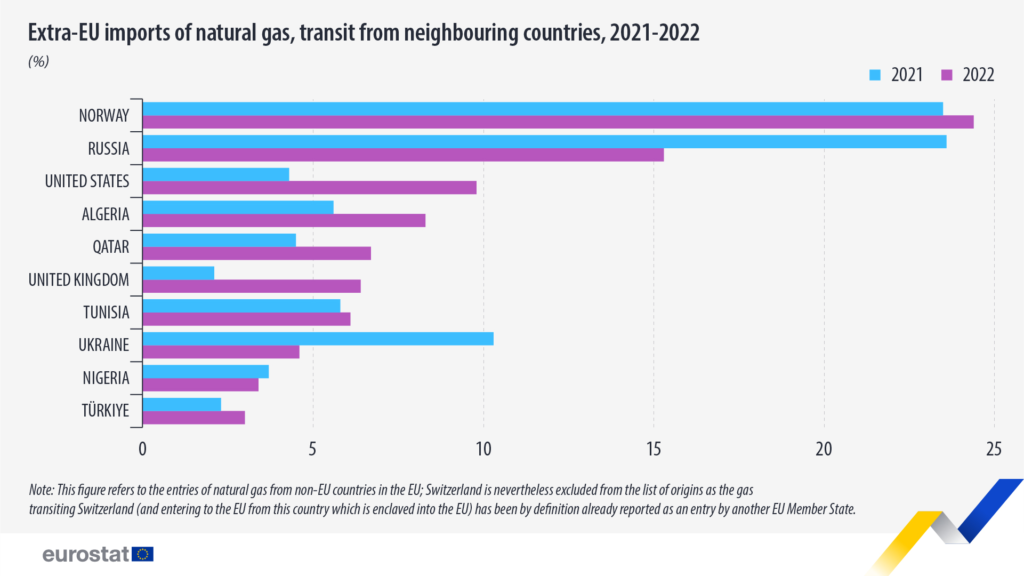
globalbizmag.com
EU’s Natural Gas Demand Decline by 13.2% in 2022
Following a 4.3% increase in 2021, the inland demand for natural gas in the European Union (EU) decreased by 13.2% in 2022 to 13.72 million terajoules. This is the third lowest total registered since 2008, when monthly cumulated data started being collected, after 2012 (12.93 million terajoules) and 2014 (13.2 million terajoules).
According to EUROSTAT, it’s important to note that one of the Council Regulation (EU) on coordinated demand-reduction measures for gas, part of the REPowerEU plan to end EU dependence on Russian fossil fuels, set a reduction target of 15% for the period August 2022-March 2023 as compared to the average of the same period of the five previous consecutive years.
Data show that the majority of EU countries reached the -15% target, with the exception of Ireland (-0.2%), Slovakia (-1.0%), Spain (-10.8%), Poland (-12.5%), Slovenia (-13.8%) and Belgium (-14.5%), which recorded smaller decreases, and Malta (smallest gas consumer among all EU members using gas), which actually saw a 12.7% increase between August 2022 and March 2023. Consumption fell the most in Finland (-55.7%), Lithuania (-40.5%) and Sweden (-37.2%) and in other EU countries, consumption dropped beyond the 15% target, in some by a large margin (above 20%).
This has triggered the reduction in demand and between August 2022 and March 2023, the EU consumption of natural gas dropped by 17.7%, compared with the average gas consumption for the same months (August-March) between 2017 and 2022.

Reduction in Consumption
In 2022, the largest natural gas consumers all reduced their demand substantially: Germany, Italy and France had the highest inland demand with 3.07 million terajoules (-15.4% vs. 2021), 2.61 million terajoules (-9.9%) and 1.54 million terajoules (-9.6%), respectively. Looking at all EU countries, demand decreased in most of them, except for Ireland and Malta where it was up slightly by 2.1% and 1.4%, respectively.
In terms of supply, total EU imports of natural gas also decreased by 6.6% from 24.67 million terajoules in 2021 to 23.05 million terajoules in 2022.
If in 2021, Norway and Russia were the main sources of natural gas entering the EU (intra-EU trade and entries from Switzerland both excluded) with similar percentages close to 24%, in 2022 the situation was quite different.
Norway was the source of 24.4% of the natural gas entering the EU, with Russia coming second with 15.3%, -8.3 percentage points (pp) than in 2021, followed by the US (9.8%, +5.5pp), Algeria (8.3%, +2.7 pp) and Qatar (6.7%, +2.2 pp). Compared with 2021, imports from Ukraine (-5.7 pp) and Nigeria (-0.3 pp) also declined, while imports from the rest of the top 10 partners increased, EUROSTAT said.
Looking at monthly data from January 2022 to March 2023, consumption has been consistently below the 2017-2022 average of the respective months of those years.
Between January and July 2022, natural gas consumption in the EU varied between 1 938 petajoules (PJ) in January and 785 PJ in July, indicating a monthly overall decrease, even before the target of 15% gas reduction was set up by the Council Regulation.
However, the biggest decreases were registered in the second part of 2022 starting in August, with a 14.0% reduction in consumption, followed by -14.3% in September, -24.4% in October, -25.0% in November, and -12.3% in December.
2023 started with further decreases of 19.0% in January (1 593 PJ) and 14.7% in February (1 435 PJ). Natural gas consumption in March 2023 reached 1 318 PJ, below the 1 589 PJ average registered between 2017-2022, with a 17.1% drop, the EUROSTAT added.










